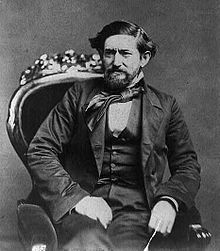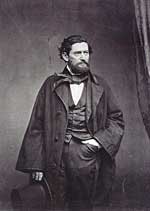Loading AI tools
American military officer From Wikipedia, the free encyclopedia
John Coffee "Jack" Hays (January 28, 1817 – April 21, 1883)[1] was an American military officer. A captain in the Texas Rangers and a military officer of the Republic of Texas, Hays served in several armed conflicts from 1836 to 1848, including against the Comanche Empire in Texas and during the Mexican–American War.
This article includes a list of general references, but it lacks sufficient corresponding inline citations. (December 2011) |
John Coffee Hays | |
|---|---|
 John Coffee Hays, circa 1857 | |
| Nickname(s) |
|
| Born | January 28, 1817 Wilson County, Tennessee, U.S. |
| Died | April 21, 1883 (aged 66) Piedmont, California, U.S. |
| Place of burial | |
| Allegiance | |
| Service | Texas Ranger Division |
| Years of service | joined Rangers in 1836 |
| Rank | |
| Commands | 1st Mounted Texas Rifles Washoe Regiment |
| Battles / wars | Texas Revolution Texas–Indian Wars |
| Other work | Sheriff, politician |
John Hays was born at Little Cedar Lick, Wilson County, Tennessee. His father Harmon A. Hays fought in the War of 1812, naming his son for a relative by marriage, Colonel John Coffee.[2]
In 1836, at the age of 19, Hays migrated to the Republic of Texas. Sam Houston appointed him as a member of a company of Texas Rangers because he knew the Hays family from his Tennessee years. He met with Houston and delivered a letter of recommendation from then-President Andrew Jackson, his great uncle. Rachel Jackson was Hays' great aunt of the Donelson family, a relative of his mother.
In the following years, Hays led the Rangers on a campaign against the Comanche in Texas, and succeeded in weakening their power. He rode with a Lipan Chief named Flacco who led the charge into every battle with him. The duo led and inspired the Rangers. In 1840 Tonkawa Chief Placido and 13 scouts joined with the Rangers to track down a large Comanche war party,[3] culminating at the Battle of Plum Creek.[4]
Later, Hays commanded the force against the invasion from Mexico of 1842. During the Mexican–American War (1846–1848), Hays commanded the First Regiment of Texas Rangers at the Battle of Monterrey, established six companies along the northern and western frontier of Texas. He then commanded the Second of Texas Rangers in Winfield Scott's Mexico City campaign. Later, while fighting under Gen. Joseph Lane, who was defending the American line of communications with Vera Cruz, Hays defeated superior numbers of Mexican cavalry at the Affair at Galaxara Pass and Mexican guerillas in the Skirmish at Matamoros and the action of Sequalteplan.[5][6][7] The Rangers excelled during this conflict, gaining nationwide fame. Hays was the first to use the Navy Colt Paterson five-shot revolver. He expedited Samuel Walker to meet with Samuel Colt which led to the design of the legendary Colt Walker six-shot revolver used in the Old West.
On April 29, 1847, in the Magnolia Hotel, Hays married Susan Calvert, a descendant of George Calvert, First Baron Baltimore, in Seguin, Texas, where he had his home.[8][9]
The Comanche had great admiration for Hays. Upon the birth of Hays' first son in California, Chief Buffalo Hump sent the Hays family a gift, a silver cup engraved "Buffalo Hump Jr."[10]
When son John Caperton Hays married Anna McMullin in San Francisco, two Texas Ranger legacies were combined. Her father, Captain John McMullin, was one of Hays' closest friends; he had followed him to California.
Jack Hays' brother was Confederate Brigadier General Harry T. Hays of New Orleans. Their sister Sarah "Sallie" Hays Hammond was the mother of John Hays Hammond.[11] John Hays Hammond, Jr., was an apprentice to Thomas Edison and worked with Nikola Tesla; he was on the board of directors for RCA.

In 1849, Hays was appointed by the United States government as the US Indian agent for the Gila River country in New Mexico and Arizona.
The same year the Hays joined the migration to California, leading a party of Forty Niners from New York that traveled in wagons to California from Texas. This party pioneered a shortcut on Cooke's Wagon Road that saved a long journey to the south. That improved route became known as the Tucson Cutoff. Hays was elected sheriff of San Francisco County in 1850, and later became active in politics. In 1853, he was appointed US surveyor-general for California.[12][4]
Hays was one of the earliest residents of the city of Oakland. In the following years, he amassed a considerable fortune through real estate and ranching enterprises. In 1860, while in Virginia City, Nevada, on business, he heard the news of the First Battle of Pyramid Lake. He commanded a force of volunteer soldiers at the Second Battle of Pyramid Lake.
During the Civil War, Hays retired from military involvement.
In 1876, Hays was elected as a delegate to the Democratic Party national convention, which nominated Samuel J. Tilden for the presidency of the United States.[4]
John Hays died in California on April 21, 1883, and his remains were interred at Mountain View Cemetery in Oakland.[4]
John C. Hays is the namesake of Hays County, Texas.[13] "Hays" is etched in his honor, on the side of the Hall of State, Dallas, Texas.
Seamless Wikipedia browsing. On steroids.
Every time you click a link to Wikipedia, Wiktionary or Wikiquote in your browser's search results, it will show the modern Wikiwand interface.
Wikiwand extension is a five stars, simple, with minimum permission required to keep your browsing private, safe and transparent.